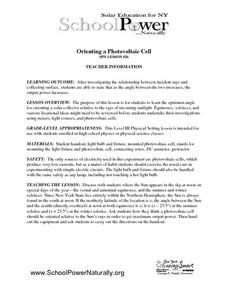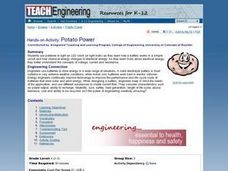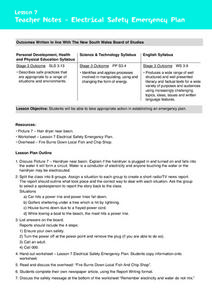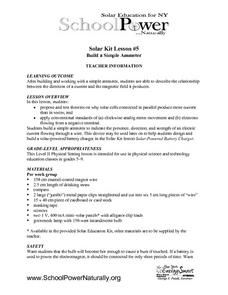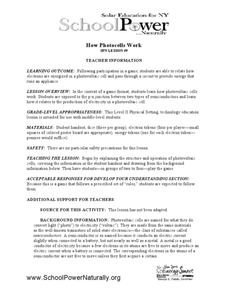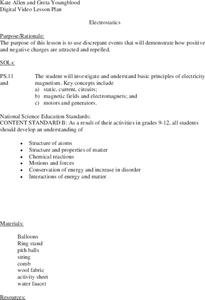Carnegie Mellon University
Battery Workshop
Introduce your class to the workings and parts of a battery-operated circuit. Pairs of pupils use lemons to make batteries and measure voltage and current with a multimeter. An accompanying worksheet is used for recording values and...
Curated OER
Electrical Safety Situations
Students determine appropriate responses to electrical emergency situations such as a downed power line. They examine an image of a fallen power line before discussing reasons that a line might be down and how to handle the situation....
Curated OER
Electricity Safety Video
Students discuss Picture 1 - Electrical Applicances. They discuss their prior knowledge of electricity and then listen to a video. They then answer the questions on the worksheet called, "Lesson 1 Electricity Safety Video" and share...
Curated OER
Orienting a Photovoltaic Cell
Students explore the optimum angle for orienting a solar collector relative to the rays of incoming sunlight. They review equinoxes, solstices, and various locational ideas before students investigate using meters, light sources, and...
Curated OER
Liquid Conductors
Students identify liquids as conductors. In this circuits lesson plan, students build a circuit, then use various liquids to complete the circuit, and determine which liquids successfully conduct electricity.
Curated OER
Potato Power
Students light a LED clock or light bulb using potatoes. They examine how a battery works in a simple circuit. They determine how chemical energy changes to electrical energy while experimenting with potato powered circuits.
Curated OER
Electricity Lesson Plan
Students conduct experiments on static electricity using the Internet. They compose a 30 second electricity safety jingle to be aired on a local radio station.
Curated OER
Electrical Safety Emergency Plan
Students discuss Picture 7 which is a hairdryer near a basin. They discover that if the hairdryer is plugged in and turned on and falls into the water it will form a circuit and anyone touching the water or hairdryer may be electrocuted....
Curated OER
What Configurations Work to Light a Bulb?
Students explore simple electrical circuits. Students experiment, using different configurations, to determine what is necessary to compeete a circuit. Students observe similarities between arrangements that work and differences in...
Curated OER
Home Electrical Safety
Students explain the danger of incorrectly wired plugs. In this physics lesson, students construct their own safe plug. They share the finished project in class.
Curated OER
Conductors, Insulators, and Semiconductors
Middle schoolers will investigate the differences in conductivity of materials, design a variety of complete circuits, and observe the differences between the manner in which light is produced in an incandescent light bulb and an LED.
Curated OER
Build a Simple Ammeter
Students build and work with a simple ammeter to test theories on why solar cells connected in parallel produce more current that in series. Students use the ammeter to indicate the presence, direction, and strength of an electric...
Curated OER
Castaway or Survivor
What a clever idea! Chemistry learners imagine themselves deserted on an island with a radio, but no batteries. They also have a few odds and ends in their pockets and storage chest. They are challenged to create a battery that will...
Curated OER
How Photocells Work
Give small groups of physical scientists tokens that represent electrons in a photovoltaic cell. They play a dice game in which they move the tokens around, representing the flow of electrons through the p-n junction of a semiconductor...
Curated OER
Electrostatics
Learners examine ways positive and negative charges are attracted and repelled by watching teacher demonstrations, and complete activity sheet related to classroom demonstration activities to prove proficiency of knowledge of...
Curated OER
Build a Tesla Coil
Students explore tesla coil through various experiments. In this physics lesson, students build their own tesla coils based on a given procedure. They discuss its real world applications.
Curated OER
General Industry Outreach Training Program
Students, after being introduced to an overview of the hazards of electricity at the workplace, view a power point presentation involving the four types of injuries that could result from contact with electricity: electrocution or death,...
Curated OER
Electricity/Magnetism
Second graders experiment with ballons to see which objects will cling and which objects will not. They use an assortment of objects, paper clips, pennies, button, scraps of paper, or puffed cereal. They make predictions and record results.
Cornell University
Making a Battery
Don't be shocked when your class has a blast making their own batteries! Science scholars examine a dry cell battery, then design and construct a wet cell battery. The activity guides them through the parts of a battery, the variables...
Curated OER
Parts of a Solar Panel-Part I
Students examine electrical contacts, solar cells, and rechargeable batteries and compare and contrast the characteristics of a solar cell to a rechargeable battery in a hands-on activity. Students complete a worksheet as they...
Teach Engineering
Changing Fields
Eddy currents, Faraday's Law and Lenz's Law provide the connection between train brakes and and MRI machines in a lesson that asks teachers to provided the material needed so the pupils can understand the properties of changing magnetic...
Curated OER
Orienting a Photovoltaic Cell
By mounting a light bulb on a stand and a PV cell on another, physics apprentices experiment with the angle of incidence. Their goal is to determine the optimum angle for collecting solar energy. The use of a scientific calculator is...
Curated OER
Map Your School
Learners participate in a project to map their school. They measure and graph various areas around the school. Learners find the longitude and latitude of the school and research the school's history, and highlight special important areas.
Teach Engineering
Six Minutes of Terror
Help your class understand the design challenges when trying to land a remote spacecraft on a planet. Class members examine the provided information to understand how each component of a spacecraft is designed in order to safely land a...





